Many industries have been hit hard by the pandemic, which has seen traditional jobs undergo a digital transformation. In this article, learn more about the benefits and challenges of employee training and the overall importance of upskilling or reskilling workers during the digital age.

In this article
Why are upskilling and reskilling more important than ever before? Technologies such as artificial intelligence (AI), cloud computing, and the Internet of Things (IoT) are automating jobs and creating newly required skill sets along the way. As new technologies evolve, employees need to learn new skills or expand their existing knowledge to ensure they are not being left behind. Employee training with tools such as learning management systems (LMS) enables SMEs to adapt to the evolving job market and stay on top of digital change.
How do employees view upskill training? What are the benefits of upskilling or reskilling staff? To find out this and more, GetApp surveyed nearly 1000 people who work for an SME to understand their attitude towards employee training and whether they find it interesting or not. The full methodology can be found at the bottom of this article.
What are upskilling and reskilling?
Upskilling and reskilling are terms that are often used interchangeably but are actually slightly different. Upskilling teaches an employee additional skills to enhance and complement their current skill set so they can progress within their company. Reskilling is the process of learning a completely new skill set in order to perform a different job or have a change of career.
A combined total of 92% of employees who were surveyed by GetApp said they were familiar with the concept of upskilling and reskilling (53% said they were ‘definitely’ familiar with them whilst 39% said they were ‘slightly’). Even though upskilling and reskilling are not new concepts, COVID-19 and the Fourth Industrial Revolution have definitely fast-tracked companies into using digital platforms for both employees and clients.
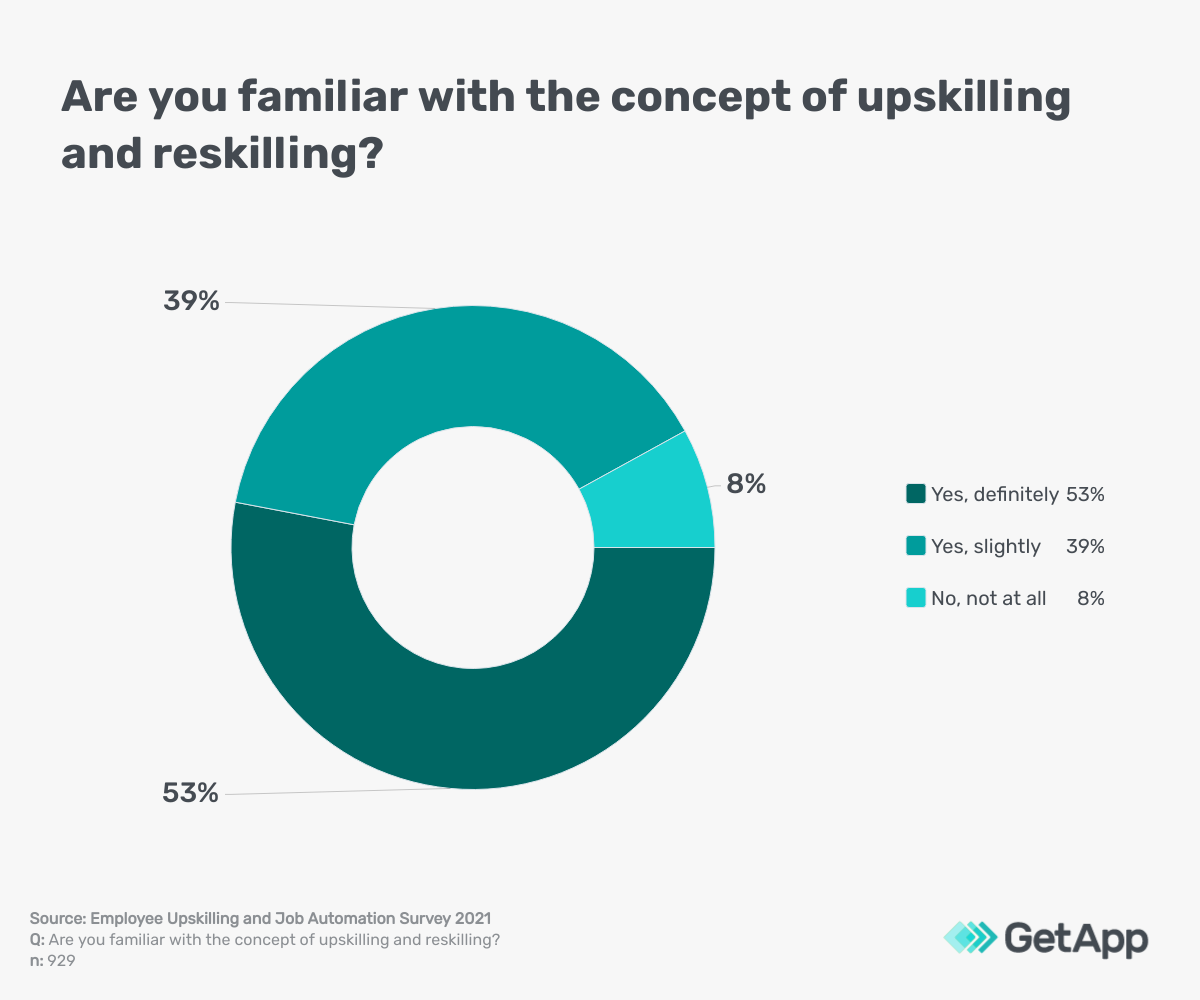
GetApp’s survey found that a combined total of 63% of employees have been upskilled or reskilled at their current company. Within this group, 19% of people said they are trained on new skills every six months or less, 19% are trained every six months, and 25% are trained only once a year or less.
COVID-19 and upskill training
The pandemic has highlighted the need for new digital skills as many businesses hit hard by COVID-19 have had to modify the way in which they provide products and services. In the retail and eCommerce world, for example, lockdowns forced most people to turn to online shopping. This not only affected retailers but wholesalers and manufacturers were impacted by the temporary closure of shops. Supply chains were disrupted, meaning logistics had to change and suddenly required strong data analysis capabilities. Businesses have had to ramp up their digital operations through the use of software tools, which has helped manage these processes. This has ultimately led to changes in staff roles and duties.
Out of the employees (63%) who have been upskilled or reskilled at their current company, 44% think that upskilling has become more important for their company since the pandemic. This may be because COVID-19 has led to a lot of job insecurity —especially for those working in retail or the hospitality sector. Gaining new skills and insight puts employees in a stronger position to change to another role within their company or find a new career path altogether.
Interestingly, 48% of upskilled or reskilled respondents think that the importance of upskilling has stayed the same in their company since the pandemic started, whilst only 7% said that upskilling had become less important to their company since the pandemic. This suggests that most businesses are either implementing new policies or maintaining and reinforcing training practices that have existed pre-pandemic.
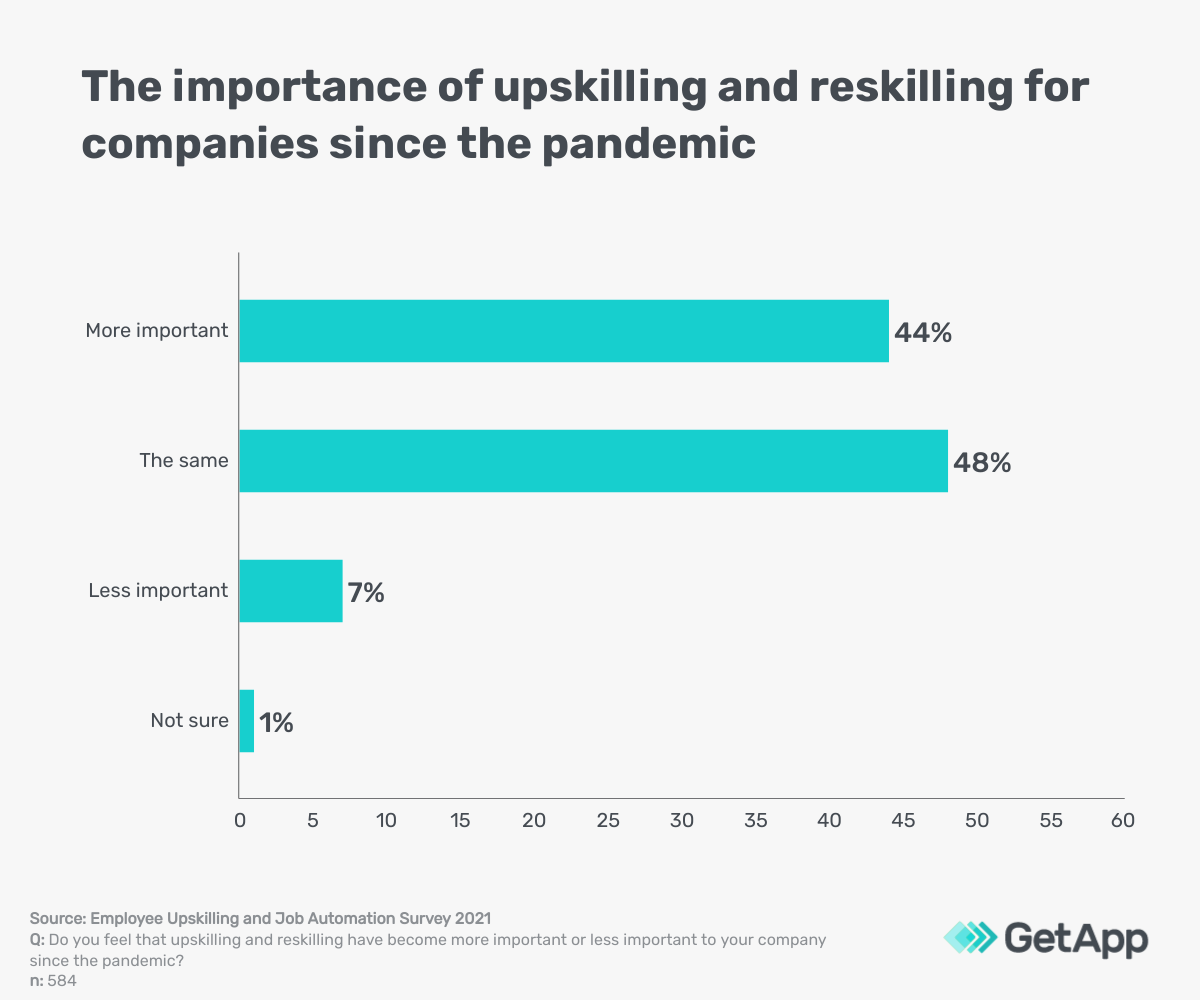
The Great Reshuffle
Early 2021 saw the start of The Great Resignation in advanced economies around the world as large numbers of employees voluntarily resigned from their jobs. In the United States, 4.5 million workers quit their jobs in November 2021 alone. COVID-19 has undoubtedly encouraged staff to rethink their work conditions, career objectives, and prospects.
Australia, however, is experiencing the latest disruption known as The Great Reshuffle in the workplace. Instead of workers quitting jobs and solely walking away, the latest trend sees employees hopping around the job market. Workers are moving towards career paths that reflect their needs, such as remote and hybrid work.

The Great Reshuffle is an opportunity for SMEs to reimagine their employee engagement strategy. Through the use of employee development plans, companies can encourage staff to work on their career objectives within the company. Some people may want to retrain within another area of the organisation or upskill for a job promotion. This leads to higher employee retention and, most importantly, not losing any talented members of staff.
Training software (also known as eLearning software) can be used by organisations to provide course registration, testing, certification and skills tracking, and reporting. These tools can also be used for onboarding and employee development.
Why is upskilling or reskilling so important?
Upskilling is key to organisational growth and equipping employees with new knowledge, which may encourage them to be more productive. Of those who have been upskilled by their current employer, 53% think that the company they work for has ‘better quality output’ as a result. 50% think that their company has ‘increased productivity,” whilst 40% said that there are ‘improved workplace relations’ due to upskilling.
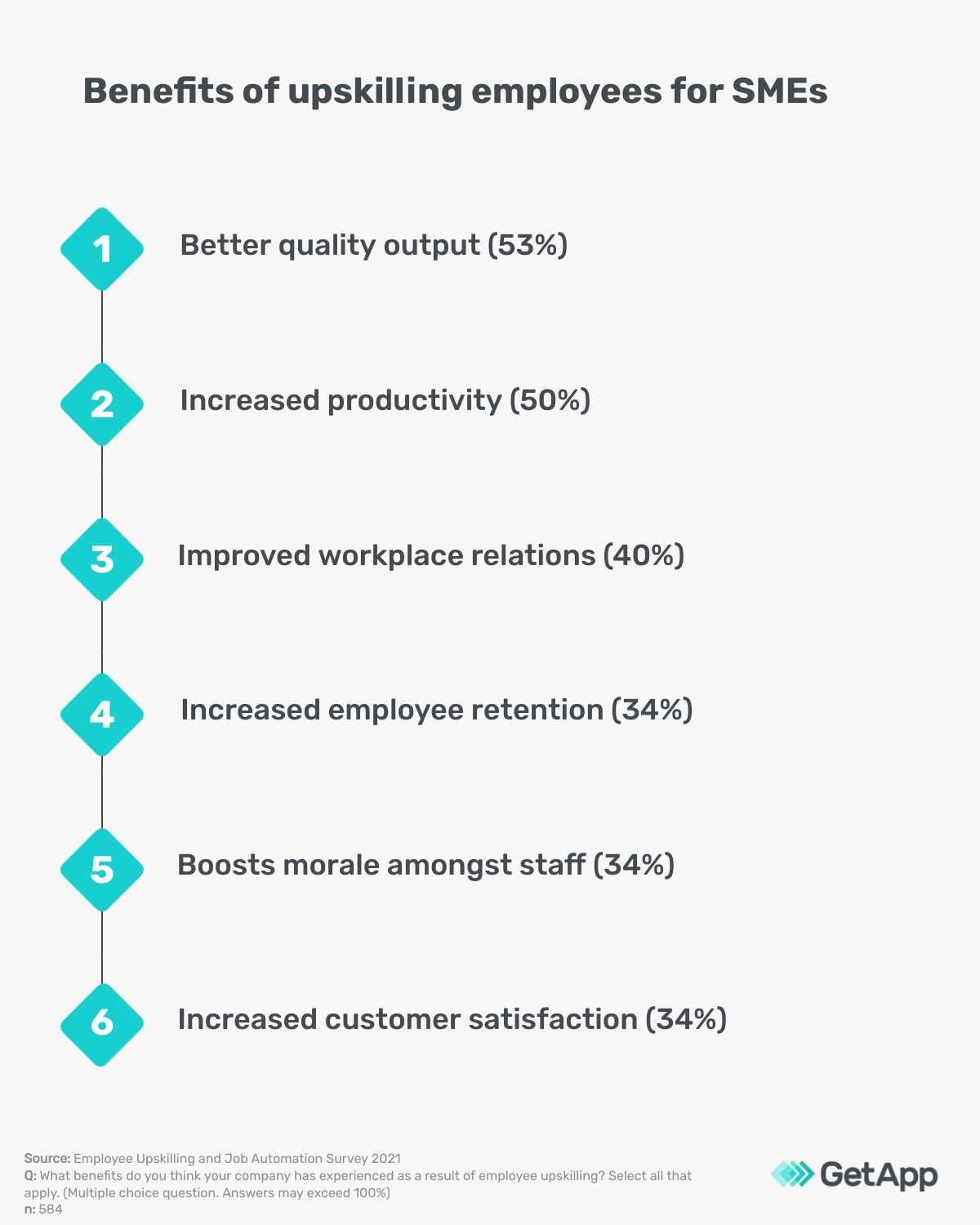
Saving on time and money are two of the biggest benefits of upskilling or reskilling employees. Focusing on talent that already exists within the company means organisations do not have to recruit, hire, and train new workers. Workplace changes will also be easier to handle as the organisation evolves. Having an employee training initiative in place will ease the impact of any unpredictable changes to the business. Another benefit of upskilling/reskilling is improving employee retention as providing development opportunities will help to keep workers on board.
How employees feel about training
Upskilling employees shows workers that their manager cares about their future within the company. Reskilling workers may help employees to feel excited about their potential career advancement. Out of the 63% of employees who stated that they have been upskilled at their current place of work, 90% of respondents within this group said that they are interested in upskilling/reskilling (46% are ‘very interested’ whilst 44% are ‘somewhat interested’).
GetApp asked those who said they have not been upskilled or reskilled by their company or who weren’t sure (37% of total survey respondents) about how they would respond if the training was implemented. 78% of this group said that they are interested in upskilling/reskilling as 36% of respondents are ‘very interested’ and 42% are ‘somewhat interested’. Upskilling/reskilling is not only good for employee morale but also saves on the costs of hiring and training new staff.
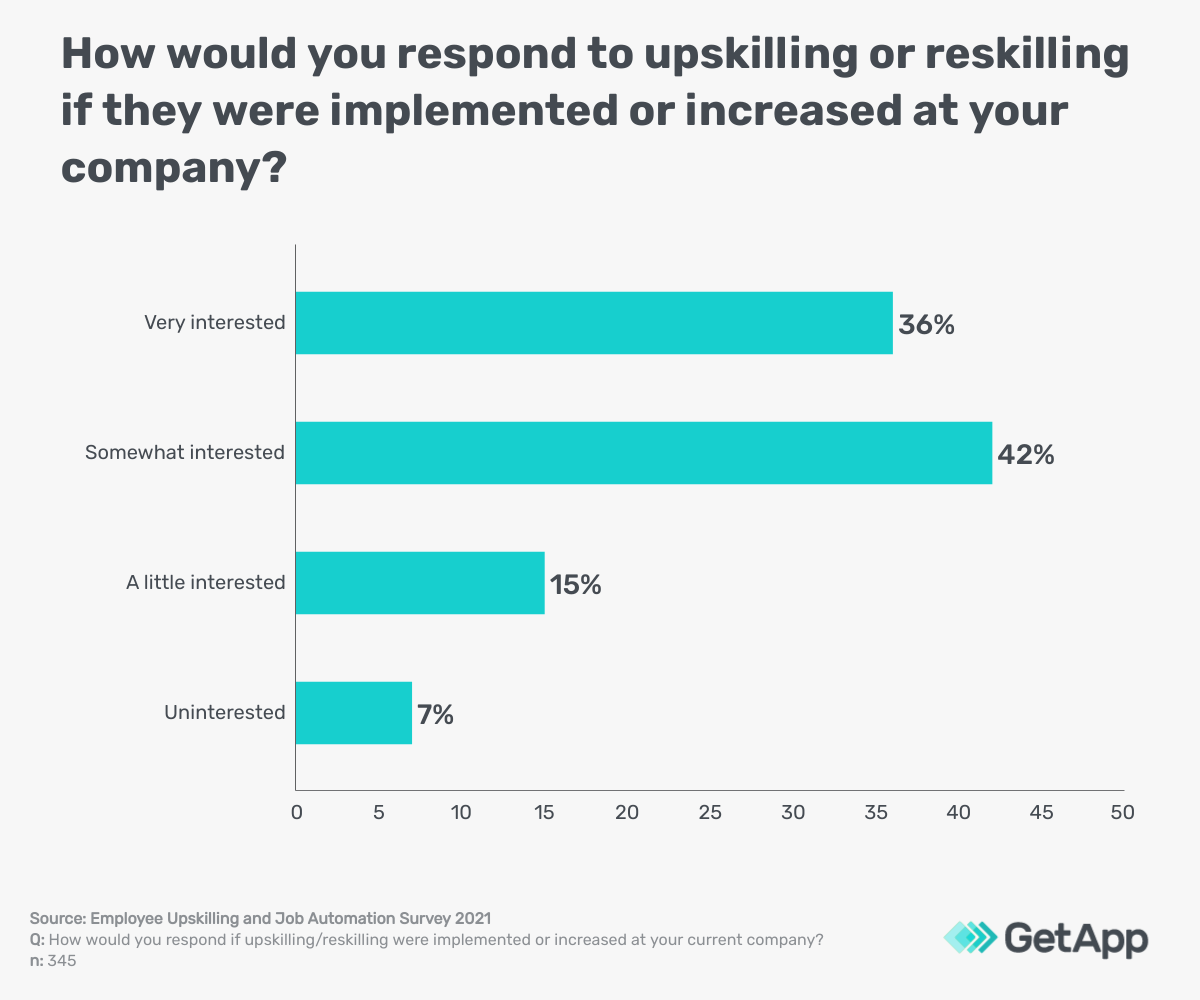
What are the challenges of upskilling employees?
Upskilling or reskilling staff is a strategic decision for SMEs but isn’t immune to facing potential challenges. Of those who have been upskilled by their current employer, 47% admit that the difference in levels and training abilities amongst colleagues is the biggest challenge of upskilling. It can be hard for employees of different levels or abilities to learn at the same time/pace, but training software allows for self-paced learning so each employee can go at their own speed.
With ever-changing digital technologies being incorporated into the workplace, employees need the knowledge and confidence to use them. Some people, however, may adapt more easily than others. It is important to monitor employees as they are learning to ensure they are coping with acquiring new transferable skills. Routinely assessing newly certified employees can help to monitor whether levels of competency are maintained after retraining.
Other challenges that employees found with upskilling/reskilling include:
- Stress levels are already high (i.e. from burnout, pandemic, job insecurity) (45%)
- Difficult keeping up to date learning new tech tools (30%)
- The training is too technical or theoretical (17%)
Learning management systems (LMS) are platforms that can help make learning and training easy for employees. LMSs are used for building courses, course management, and course tracking, which can help companies to build custom training plans, design courses, and track employee progress on an individual or team basis.
How to upskill a workforce
It is important for SMEs to empower employees with digital training and an upskilling plan. Out of the group of respondents who have been upskilled or reskilled at their current company (63%), 48% said that their employer encouraged personal development plans. 43% of the upskilled group said their company allocated training time for workers and 33% said their employer introduced software tools for upskilling/reskilling training.
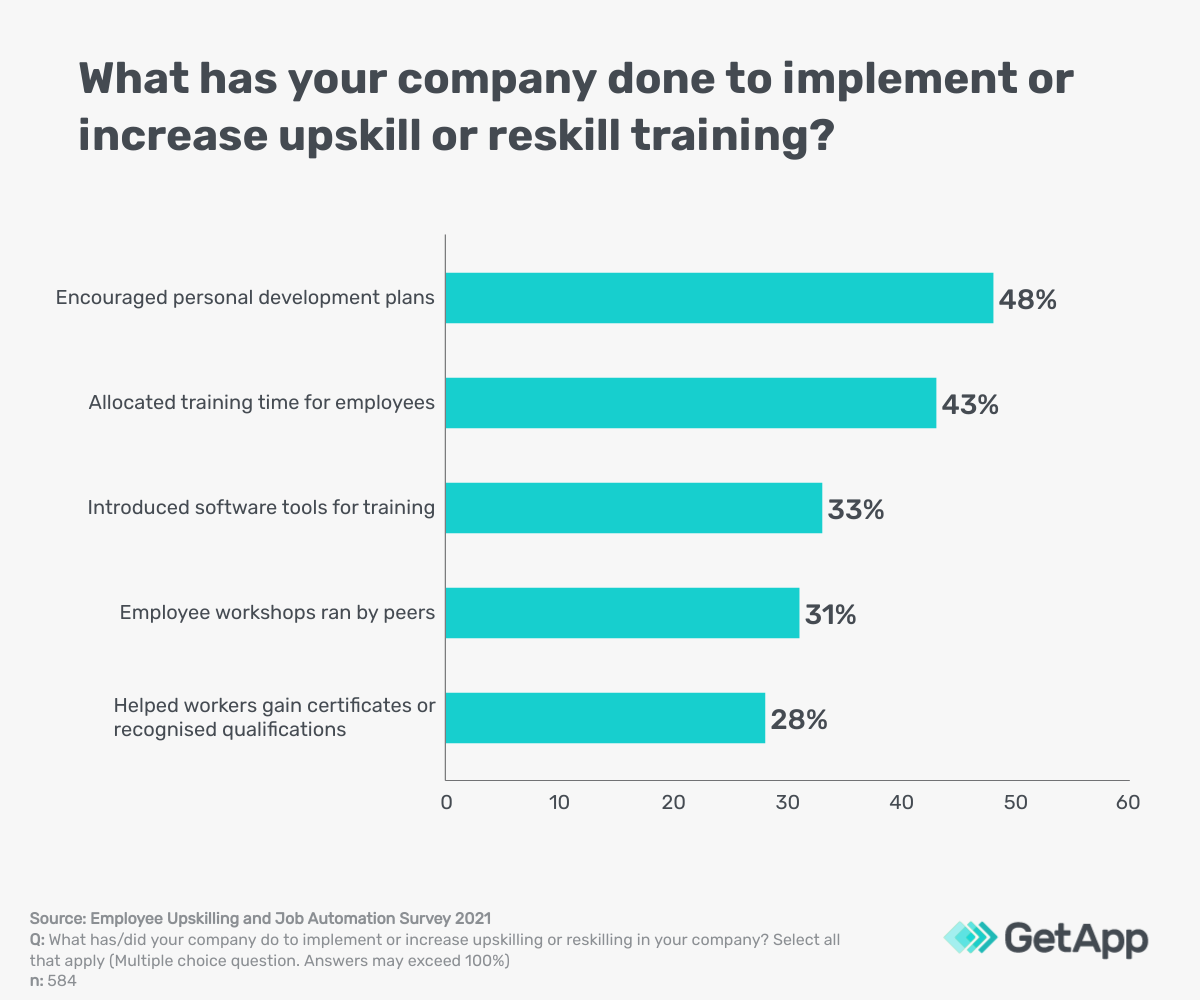
Tips for upskilling employees
- Conduct a skills gap analysis: determining the skill gap amongst workers through the use of LMS reports, employee assessments, and Key Performance Indicators (KPIs) can help to identify employees who may require reskilling in the workplace.
- Make upskilling/reskilling available to everyone: to get employees on board with broadening their skill set, organisations should build upskilling into employee development plans. Whilst some staff may be more enthusiastic than others, it is still important to make upskilling training accessible for everyone.
- Find the best employee training method: try to accommodate different learning styles. Some people may be visual learners, some might require in-person training, whilst others may prefer learning online. Understanding the different learning styles of employees is helpful especially if providing a variety of tools —eLearning, coaching, peer learning, video training, virtual workshops— which can be beneficial to everyone.
- Track and monitor progress: evaluate the upskilling training to see if the objectives were reached. LMS and training software can help SMEs measure the effectiveness of the upskill program by monitoring employee performance and assessment scores.
- Reward employees: Give incentives for all of their upskilling or reskilling efforts. Employee recognition software can help managers keep their team rewarded, which boosts employee morale and in turn leads to a more productive workforce.
Final considerations
Upskilling and reskilling employees are vital as we move into the age of the Fourth Industrial Revolution, which is digitally transforming the way in which we do business. Upskill training can improve employee performance and lead to higher job satisfaction rates. Reskilling helps to fill in skill gaps and ensure that workers are knowledgeable and well equipped for the organisation’s goals.
Survey methodology
Data for the Employee Upskilling and Job Automation Australia Survey 2021 was collected in October 2021. The sample comes from an online survey of 929 respondents who live in Australia. The respondents were of the age groups 18 to 25 years, 26 to 34 years, 35 to 49 years, 50 to 64 years, and 65 and above. The respondents were employed full- or part-time and worked at a company with between 2 and 250 employees.
